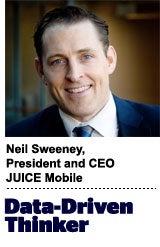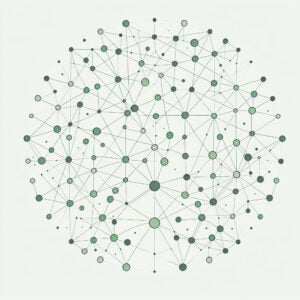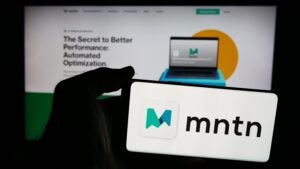 “Data-Driven Thinking” is written by members of the media community and contains fresh ideas on the digital revolution in media.
“Data-Driven Thinking” is written by members of the media community and contains fresh ideas on the digital revolution in media.
Today’s column is written by Neil Sweeney, president and CEO at JUICE Mobile.
There has been a lot of discussion lately about programmatic direct and its future.
We can all agree that the industry moves at a speed that could break the sound barrier, but unfortunately, we can’t seem to agree on what programmatic direct really means. This lack of industry consensus around the definition of programmatic direct is preventing the technology from growing and innovating.
So before we can have a real conversation about where it’s headed, let’s clarify what programmatic direct is – and is not.
Defining Programmatic Direct
Programmatic direct is not real-time bidding (RTB) or any of its countless variations, all of which transact on current impressions. Programmatic direct is also not the private marketplace, which is, at its core, a glorified RTB solution.
Simply put, programmatic direct is about securing guaranteed impressions into the future via automation. In contrast, RTB, including private marketplaces, involves bidding on nonguaranteed impressions right now via a biddable pipe.
There is a biddable pipe and an automated pipe. The biddable pipe is used for impressions that will be served immediately. The automated pipe, which runs via an API integration into a publisher’s ad server, is used for impressions served tomorrow or beyond.
Here’s how the three buying methodologies work.
The open exchange (RTB) guarantees advertisers nothing (except maybe a headache). Rates and impressions are dynamic and free-floating.
The private marketplace guarantees advertisers a publisher and a rate but not impressions, which are open to bidding from all others in the private marketplace, as well as dynamic allocation on the direct side.
Programmatic direct guarantees what the others do not: publishers, rates and impressions. This makes programmatic direct fundamentally different than the other two.
Programmatic direct is often associated with premium inventory. Nonpremium inventory is more likely to be found in an exchange where the desire for audience trumps environment. Exchanges are often dominated by publications and applications that either cannot drive direct demand or are too small to warrant a sales team, hence the biddable pipe.
Yes, there are examples of premium publications exposing inventory in the exchanges but, if these publications really embraced the exchange’s true methodology, there wouldn’t be a need for a private marketplace at all. Rather than looking for new tools to solve new problems, people are hacking the pipe and implementing workaround solutions (header bidding, anyone?) to address problems and challenges that the biddable pipe was not originally created to solve.
Changing Definitions
Over the past year, I’ve seen a movement to change the definition of programmatic direct to suit the needs of certain suppliers. For example, some supply partners claim that 60% of their inventory is transacted via programmatic direct, while others classify anything in their private marketplace as being programmatic direct.
There is a simple reason why this is happening: Some suppliers are trying to make it seem as if their inventory is more premium and guaranteed – and less likely to be fraudulent. But the situation I described is a straight-up private marketplace. Unless vendors integrate directly into the ad servers of their publishing partners and guarantee the inventory, it is not programmatic direct.
There has always been a well-documented absence of a consistent definition of programmatic direct. “Automated guaranteed” or “premium guaranteed” are terms that are frequently used interchangeably with programmatic direct because they too involve securing guaranteed impressions into the future. While not fundamentally different, jumping back and forth among these terms simply adds more confusion to a marketplace that few truly understand.
The industry needs to adopt standard terms to describe two different models and stick to them. I propose programmatic direct and RTB, using the above definitions.
The Current State Of Programmatic Direct
Historically, at scale, business models fragment. Facebook, Twitter, Instagram and Snapchat demonstrate how the social channel has fragmented as it scaled over the past 12 years. The previous model is not replaced; instead, others add to it.
I would argue that the industry has spent the last five years building up the scale of RTB to a point where it is now ripe for fragmentation. Fragmentation in programmatic direct is the logical next step, with sophisticated buyers and sellers using both RTB and programmatic direct to mitigate delivery, quality and cost risks. RTB and programmatic direct have a symbiotic relationship and should be used in conjunction with one another.
The belief that everything should be transacted in a real-time pipe is pure arrogance and a bit of Kool-Aid drinking. It fails to learn from more mature programmatic models, such as currency or commodities exchanges, which have struck the balance between the “spot” market (RTB) and the futures market (programmatic direct).
Ultimately, the success of programmatic direct depends on the continued success of RTB. As RTB is further embraced, the risk of underdelivery and cost acceleration increases. The need to mitigate these risks simultaneously also grows.
We are quickly approaching an inflection point where those with too much to lose by underdelivering or facing cost overruns will need to venture outside the RTB pipe to secure inventory. This is best done in a programmatic direct environment. It will be an inevitable part of everyone’s strategy in the future.
Innovate or die – or, at minimum, underdeliver.
Follow Neil Sweeney (@NEILatJUICE), JUICE Mobile (@JUICE_Mobile) and AdExchanger (@adexchanger) on Twitter.













